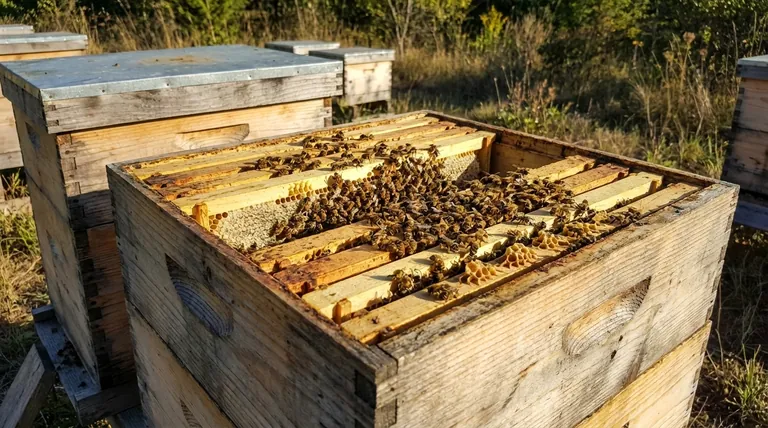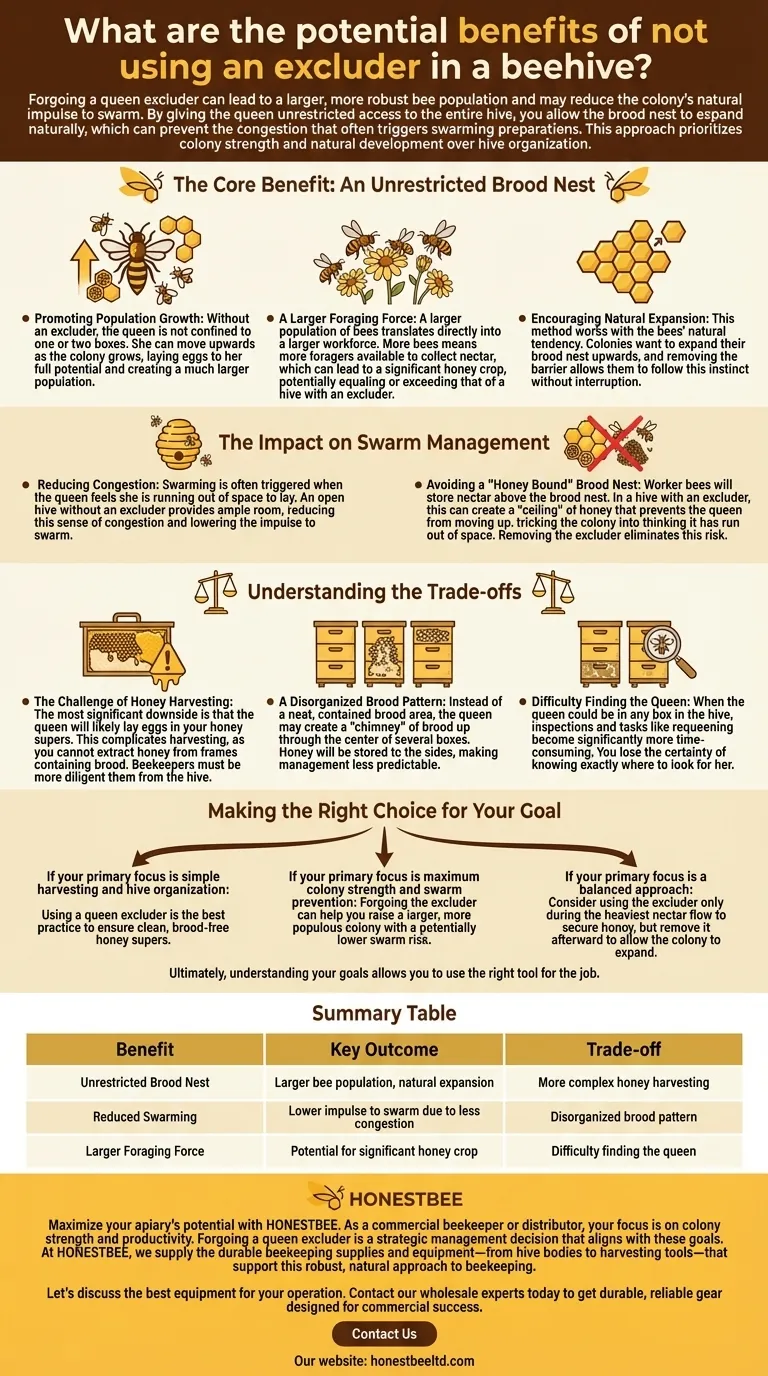Forgoing a queen excluder can lead to a larger, more robust bee population and may reduce the colony's natural impulse to swarm. By giving the queen unrestricted access to the entire hive, you allow the brood nest to expand naturally, which can prevent the congestion that often triggers swarming preparations. This approach prioritizes colony strength and natural development over hive organization.
The decision to not use a queen excluder is a strategic choice that favors maximum colony population and natural expansion, at the cost of a more complex and less predictable honey harvest.

The Core Benefit: An Unrestricted Brood Nest
The primary advantage of removing the excluder is allowing the queen to lay eggs wherever she finds suitable space. This directly impacts the colony's potential.
Promoting Population Growth
Without an excluder, the queen is not confined to one or two boxes. She can move upwards as the colony grows, laying eggs to her full potential and creating a much larger population.
A Larger Foraging Force
A larger population of bees translates directly into a larger workforce. More bees means more foragers available to collect nectar, which can lead to a significant honey crop, potentially equaling or exceeding that of a hive with an excluder.
Encouraging Natural Expansion
This method works with the bees' natural tendency. Colonies want to expand their brood nest upwards, and removing the barrier allows them to follow this instinct without interruption.
The Impact on Swarm Management
One of the most debated topics in beekeeping is the excluder's role in swarming. Omitting it can be a powerful swarm prevention tool.
Reducing Congestion
Swarming is often triggered when the queen feels she is running out of space to lay. An open hive without an excluder provides ample room, reducing this sense of congestion and lowering the impulse to swarm.
Avoiding a "Honey Bound" Brood Nest
Worker bees will store nectar above the brood nest. In a hive with an excluder, this can create a "ceiling" of honey that prevents the queen from moving up, tricking the colony into thinking it has run out of space. Removing the excluder eliminates this risk.
Understanding the Trade-offs
While beneficial for colony growth, this approach creates specific challenges that require a different management style.
The Challenge of Honey Harvesting
The most significant downside is that the queen will likely lay eggs in your honey supers. This complicates harvesting, as you cannot extract honey from frames containing brood. Beekeepers must be more diligent in checking frames before taking them from the hive.
A Disorganized Brood Pattern
Instead of a neat, contained brood area, the queen may create a "chimney" of brood up through the center of several boxes. Honey will be stored to the sides, making management less predictable.
Difficulty Finding the Queen
When the queen could be in any box in the hive, inspections and tasks like requeening become significantly more time-consuming. You lose the certainty of knowing exactly where to look for her.
Making the Right Choice for Your Goal
The decision to use an excluder depends entirely on your beekeeping philosophy and objectives.
- If your primary focus is simple harvesting and hive organization: Using a queen excluder is the best practice to ensure clean, brood-free honey supers.
- If your primary focus is maximum colony strength and swarm prevention: Forgoing the excluder can help you raise a larger, more populous colony with a potentially lower swarm risk.
- If your primary focus is a balanced approach: Consider using the excluder only during the heaviest nectar flow to secure honey, but remove it afterward to allow the colony to expand.
Ultimately, understanding your goals allows you to use the right tool for the job.
Summary Table:
| Benefit | Key Outcome | Trade-off |
|---|---|---|
| Unrestricted Brood Nest | Larger bee population, natural expansion | More complex honey harvesting |
| Reduced Swarming | Lower impulse to swarm due to less congestion | Disorganized brood pattern |
| Larger Foraging Force | Potential for significant honey crop | Difficulty finding the queen |
Maximize your apiary's potential with HONESTBEE.
As a commercial beekeeper or distributor, your focus is on colony strength and productivity. Forgoing a queen excluder is a strategic management decision that aligns with these goals. At HONESTBEE, we supply the durable beekeeping supplies and equipment—from hive bodies to harvesting tools—that support this robust, natural approach to beekeeping.
Let's discuss the best equipment for your operation. Contact our wholesale experts today to get durable, reliable gear designed for commercial success.
Visual Guide

Related Products
- Premium Wood Framed Metal Wire Queen Bee Excluder
- High Performance Plastic Queen Excluder for Beekeeping and Apiary Management
- Professional Plastic Queen Excluder for Modern Beekeeping
- Plastic Queen Bee Excluder for Bee Hive Wholesale
- Wooden Queen Bee Excluder for Beekeeping
People Also Ask
- What is the primary function of a queen excluder? A Guide to Brood-Free Honey Harvesting
- What makes polyurethane foam environmentally friendly? The Surprising Benefits of a Durable, Inert Material
- Do I really need a queen excluder? A Guide to Maximizing Your Honey Harvest Efficiency
- What are the advantages of using a queen excluder? Maximize Honey Yield & Hive Control
- Can a queen get through a queen excluder? A Guide to Preventing Hive Failures



















